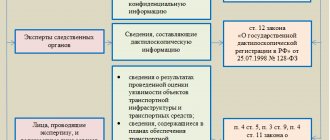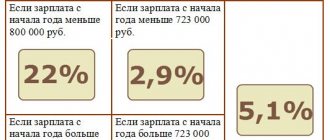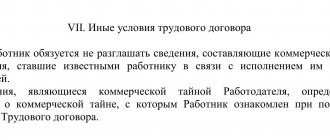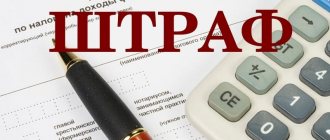What the law says
Issues of protection of confidential information are regulated by the Civil Code of the Russian Federation, as well as the special Federal Law of July 29, 2004 No. 98-FZ “On Trade Secrets”.
In accordance with Art. 3 of this law, a trade secret is a regime of confidentiality of information that allows its owner, under existing or possible circumstances, to increase income, avoid unjustified expenses, maintain a position in the market for goods, works, services, or obtain other commercial benefits. Each organization decides independently which production, technical, economic, organizational or other information is classified as confidential. Only certain data cannot be classified, for example, about the number of employees, the payment system and working conditions, and some others. But holding people accountable for disclosing trade secrets is expressly established by law.
What is meant by tax secrecy?
We examined the essence and concept of a trade secret. One of its aspects and directions is tax secrecy. In accordance with the standards prescribed in Art. 102nd Tax Code of the Russian Federation, NT means a set of information about payers that was obtained by:
- investigative organizations;
- tax offices;
- representatives of the internal affairs department;
- off-budget federal funds;
- customs companies.
And since 2020, this category also includes information about the amounts of insurance payments that were made by taxpayers. The Tax Code (Article 102) also states that it has nothing to do with NT:
- data on tax reporting documents;
- materials on the number of employees of the company;
- information about taxation systems for the population;
- information about insurance contributions and their tariff features;
- non-compliance with regulations in the field of fees.
In Art. 183 of the Criminal Code of the Russian Federation it is noted that a certain amount of responsibility is assigned for illegal acts, because they can cause direct or indirect damage to the company itself.
According to the text of Article 102 of Federal Law No. 146, adopted on July 31, 1998, tax secrecy should be understood as any information about the payer of insurance premiums, the taxpayer, received by the tax, investigative, customs authorities, internal affairs bodies and state bodies. not a budget fund. Part one of this rule also contains an exhaustive list of information that is an exception to the general rule of non-disclosure.
Options for prosecution
Different types of violation of trade secret rights provide for different degrees of punishment. Depending on the methods, motives, as well as the resulting amount of damage caused, the perpetrators may be held liable for the following types of liability for disclosing other people’s secrets:
- disciplinary - up to and including dismissal;
- civil law - in the form of compensation for material damage;
- administrative;
- criminal
Let us consider in more detail what sad consequences, from reprimand to imprisonment, can result from non-compliance with a trade secret. Naturally, only if its owner followed the procedure for introducing a secrecy regime and there is evidence of the violator’s guilty actions.
Procedure
To bring a person to justice for the crime in question, certain conditions will need to be met:
- the company must have a trade secret regime;
- it is necessary to prove the fact of disclosure of data.
The secrecy regime provides that the organization's management takes measures to limit access to information. This applies to third parties. It is worth pointing out that it is necessary to use a strong evidence base. The punishment process comes down to performing several actions. First of all, the company's management establishes the fact of disclosure. This is done based on direct or indirect evidence.
Then they begin an internal investigation. During it, all the circumstances of the case are studied. The person suspected of disclosure is asked to explain the situation. The document reflects the circumstances and reasons that the company used to draw its conclusions.
We invite you to familiarize yourself with: Punishment for light beatings under Art. 116 of the Criminal Code of the Russian Federation: what can happen and what liability threatens for causing harm to health?
When the employee has read the paper, he puts his signature on it. The company must wait for the person to provide an explanation in writing. The law allocates a couple of days for this process.
If a person does not take any actions and ignores the requirements of management, an appropriate act is drawn up. Next, a commission is formed that evaluates the circumstances of the disclosure and makes a decision regarding prosecution. At the final stage, a protocol is drawn up.
Based on the protocol, an order is formed stating that liability is applied to the employee. All acts that were created during this procedure must be saved. This is necessary in order to further prove that you are right if the employee decides to appeal the decision.
Disciplinary action
By virtue of Art. 192 of the Labor Code of the Russian Federation, a disciplinary offense is recognized as the failure or improper performance by an employee, through his fault, of the labor duties assigned to him, including the implementation of the procedure for handling the employer’s secret data. Therefore, for disclosing them, a disciplinary sanction may be imposed on the employee, and not only in the form of a reprimand or reprimand. Dismiss an employee according to paragraphs. “c” of paragraph 6 of part 1 of Article 81 of the Labor Code of the Russian Federation is possible after the first violation, since it is considered gross.
What can be considered classified information?
The following types of important information are considered trade secrets:
- Information about the company’s activities (main and non-core activities, existing licenses or intentions to obtain them, documents and statements with which the company’s representatives apply to various authorities, for example, the Antimonopoly Committee).
- Secrets about the company's partners (the number of such partners, contact details of these enterprises and their managers, the content of business correspondence, data on lawsuits and litigation, formal or informal relations with representatives of other organizations and third parties).
- Documents on the organization of management at the enterprise (for example, data on the structure of the company and its divisions and the relationships between them, information on software and other hardware, job descriptions of employees, as well as various passwords, barcodes).
- Documents related to material and economic activities (including information about the technologies used in production, transactions carried out and the content of the contracts that secure them, the existing property of the organization, the amount of cash turnover, financial manipulations).
- About existing inventions , scientific and technical innovations, and other advanced technologies that are considered the property of this company.
- About the existing security systems used at the enterprise.
- Base contained in constituent and other management documents.
- Information about the company's managers, their contact details.
- Knowledge of working conditions in the organization.
How much tax evasion is subject to criminal liability? Find out the answer right now.
Financial liability for disclosure of trade secrets
The employer has the right to recover damages arising from the disclosure of secret information, not only during the period of validity of the employment contract, but also from the former employee if there is an obligation to non-disclose trade secrets after dismissal (Part 4 of Article 11 of Law No. 98-FZ). Such recovery is carried out in court on the basis of evidence provided by the employer of the fact and amount of damage caused. The period for non-disclosure of trade secrets after dismissal is not established by law and is prescribed by the employer in an agreement with the employee independently. In practice, this period is usually no more than five years.
All these provisions must be included in the text of the agreement with the employee on the trade secret regime.
Other violations
In addition to disclosing secret information, the employer has the right to accuse the employee of collecting secret information through unlawful means for the purpose of subsequent use. Judicial practice defines the following methods of data collection:
- Theft of documents;
- Hacking of production systems;
- Penetration in premises where commercial documentation is located.
All such violations are quite serious, because they involve intent. If such actions are detected, the employer has the right to contact the police. On this basis, an investigation will be conducted and all facts and documents related to the activities of the data thief will be checked.
Trade secrets in the Code of Administrative Offenses
In accordance with Art. 13.14 of the Code of Administrative Offenses of the Russian Federation, disclosure of legally protected secrets of an enterprise by a person who has gained access to such information in connection with the performance of official or professional duties shall entail the imposition of an administrative fine. Please note that this rule applies only in cases where there is no criminal liability for an employee for disclosing a trade secret. The size of the fine imposed is small - from 500 to 5,000 rubles, so employers relatively rarely use this method of influencing negligent employees.
Definition of mystery
Information that is of interest to the organization's competitors constitutes a trade secret.
The information may concern:
- production technology;
- procurement planning;
- price policy;
- plans for development, etc.
To keep information secret, companies have to put in a lot of effort. When company employees tell someone this information, they are held accountable for what they have done. Secrets include various activities of the company. The data is of interest to competing companies. Competitors are also interested in future plans related to sales.
Trade secrets in the Criminal Code
Competing firms often try to intercept each other's secret information in order to use it for their own purposes. Therefore, the most common and harmful way of disclosing confidential data is the theft of trade secrets for sale to competitors. But the punishment for such an act is much more severe. Disclosure of a trade secret in the Criminal Code of the Russian Federation (Article 183) is interpreted as a criminal offense, therefore, the following types of punishment may be applied to the perpetrators, depending on the severity of the offense:
- correctional or forced labor;
- imposition of a fine of up to one and a half million rubles;
- ban on working in certain positions;
- imprisonment for a term of up to seven years.
Subjects of espionage
The subjective side of the analyzed criminal act and its subject differ depending on what specific part of Art. 183 of the Criminal Code of the Russian Federation is in question. Let's look at each point in more detail.
Thus, the purpose of a crime classified under the first part of the analyzed norm cannot be selfish (that is, obtaining a benefit of a material nature), since this is a sign of part 3. In this case, there is direct intent. However, information is collected, as a rule, for its subsequent use. The subject of the first part is general, i.e. a person over the age of 16 years old, of sane mind.
The subjective side of a criminal act that falls under part two of Article 183 of the Criminal Code is also characterized by direct intent and, most often, personal interest. The subject changes, in this case it is special. This is a person over sixteen years of age who has been entrusted with, or due to the nature of the work or service has become aware of, a secret (commercial, tax or banking).
As judicial practice shows under Art. 183 of the Criminal Code of the Russian Federation, the lion's share of crimes is related to industrial espionage. In other words, the most common illegal disclosure or receipt of certain data that constitutes a trade secret.
The subject of a criminal attack or a spy can be any person:
- over sixteen years of age;
- who became the owner of secret data constituting an industrial secret due to his job duties;
- acting to achieve a criminal result for any motive and by any means available to him.
Arbitrage practice
Just a few years ago, questions about whether video surveillance is a violation of trade secrets or whether an employer has the right to monitor the personal correspondence of its employees from a company computer seemed almost exotic. But despite the fact that Russian entrepreneurs today do not often go to court to protect their secrets, now the judicial practice on trade secrets has already developed quite extensively, both in civil and criminal cases.
Example 1
N. worked as a leading engineer in a manufacturing company. Having access to his manager’s computer, he secretly copied confidential information about new technologies and sent them to an acquaintance working in a competing company, who, in gratitude, paid for his family to vacation at a fashionable resort and promised to give his wife N a job. After the initiation of a criminal case on According to the employer's statement, N.'s actions were qualified by the court as theft of a trade secret with a punishment of 1 year and 8 months of forced labor.
Example 2
S. worked as a cleaner in a design office. In the stack of documents prepared by employees for disposal, which S. took home for household needs, there were drawings of the latest design development. The papers caught the eye of S.’s nephew, who shared them with friends by posting them on his Internet page.
S. was fired for disclosing confidential information, but the court considered the dismissal illegal for the following reasons: S. was not aware that the data was secret; the employer did not take appropriate measures to protect its secrets.
Stories of industrial espionage
https://youtu.be/DjQ9gtuPMjk
History has known and still knows a million examples of crimes in the sphere of theft of production secrets of certain items. We list the main ones:
- The theft of Chinese silk production technology by two Nestorian monks in 522 AD. e. They took from China components prohibited for transportation in their walking poles, which had hiding places. This is the first example of large-scale state industrial espionage in history. The value of this information, coupled with knowledge gained from other secret places about the construction of looms, led to the creation of an entire industry in the Eastern Mediterranean.
- In the 30s of the 20th century, Soviet intelligence officers brought Ceylon tea bush seedlings to the Georgian SSR.
- Samuel Slater stole (memorized) weaving technology from Great Britain and founded the first American weaving mill in 1789.
- British industrial spies took the rubber crop, which was prohibited from import, from Brazil and cultivated it in Malaya. Thereby revealing the secret of natural rubber.
- In 1985, Eugene Mayfield, a former Procter {amp}amp; Gamble, stole and attempted to sell a strategic marketing plan to boost sales of Crest brand toothpaste. A deal to sell valuable information fell through, and the unsuccessful spy was caught at the crime scene with marked banknotes.
- In 1998, Caddilac Gage filed a lawsuit alleging the possible theft of industrial documents from it. The trial was lost due to poor organization of security at the production buildings.
Espionage (gathering information) continues to flourish to this day. International espionage is relevant due to the strained relations between the actors of world powers. The theft of advanced technologies and ideas will never stop as long as there is competition in private business, which is the engine of progress.
Tags: commercial, responsibility, industrial, disclosure, secret, espionage
About the author: admin4ik
« Previous entry
How is disclosure proven?
How can you prove the disclosure of an organization's trade secret? In order for the guilty employee to be assigned a form of punishment, two basic conditions must be met :
- taking measures within the enterprise to protect information;
- availability of evidence of the spread of CT.
To take a winning position in court, you need to take several actions:
- establish the fact that the CT scan was disclosed by providing evidence;
- conduct special investigations within the organization using the established commission;
- send a written request to the suspected person demanding an explanation on his part;
- start drawing up a document - an act (in the absence of explanatory information received from the informer);
- decide that, one way or another, the guilty person will be held accountable.
The following factual points may serve as direct evidence of disclosure:
- discovery of papers from a suspect that contain CT scans;
- the presence of video materials obtained through CCTV cameras;
- recording the fact of sending secret information;
- availability of testimony.
Types and elements of crime
The concept of violation of trade secrets refers to the following acts of the violator:
- dissemination of materials about the organization that are considered secret;
- allowing confidential information to fall into the hands of third parties;
- sale of CI to persons who use it for personal gain.
The composition is technically formal, i.e. the act was committed regardless of the result: whether only certain attempts were made, or whether the information ended up in the hands of competitors and other third parties who, in theory, should not have access to this information.
Comments on Article 183
Much of the information in the subject and citizen sphere is of value or commercial relevance to organizations, partners and clients. Therefore, special treatment is provided for it. Some information is not subject to public disclosure. The status of such information is called secret.
Commentary to Article 183 of the Criminal Code of the Russian Federation:
- The danger of a crime lies in the possibility of causing harm to business entities due to unlawful actions regarding secrets. Disclosure of information about the status of a bank account violates a citizen's constitutional rights to privacy.
- Parts 1 and 2 describe crimes of minor gravity, 3 – medium, and 4 – serious. Object – social relations in the sphere of information circulation. Such information in the form of a secret will be the subject. Storage media (floppy disks, hard drives) in documentary or non-documentary form do not form an object.
- A secret is hidden information that is not known to everyone, a secret. It is incorrect to say that bank secrecy is part of commercial secrecy or identifies it. Bank secrecy has specific features.
- Information is secret when it has commercial value. The owner takes measures to maintain confidentiality.
- According to Federal Law No. 98 “On Trade Secrets”, this is a regime of information confidentiality, through which the owner can increase income, avoid unnecessary expenses or receive benefits.
A production secret or trade secret is information of any nature, including the results of intellectual activity. These are ways of carrying out professional activities that have commercial value. The latter do not have free access to it. A special regime has been introduced for such information.
Information that does not constitute a secret is determined by law. These are constituent documents, charter, registration certificates, patents, licenses, reporting for checking taxes and calculating accounting payments, privatization, public issue of securities.
The bank is obliged to guarantee the secrecy of accounts and deposits, information about clients. The Central Bank guarantees secrecy if this does not contradict the Federal Law. The secret may be disclosed to government bodies and officials entitled to do so (Article 857 of the Civil Code), clients and client representatives.
Persons requesting information about the secret are specified in Art. 26 of the Law “On Banks”. These are judges, customs authorities, the Chamber of Accounts, preliminary investigation authorities in agreement with the prosecutor. Certificates about the account and deposit upon the death of the owner are issued to the persons specified in the will, to notary offices for inheritance matters, and in the case of foreign citizenship - to foreign consulates.
Punishment for disclosing the secret of adoption under the Criminal Code of the Russian Federation, Article 155
The Central Bank does not disclose information to auditors about accounts, deposits, transactions, operations from reports. Auditors do not have the right to disclose information to third parties. In February 2002, to prevent money laundering, information on transactions of legal entities and citizens without such education was submitted to Rosfinmonitoring. The body does not have the right to disclose information to third parties.
Tax secret is any information about the taxpayer received by the authority. Exceptions: TIN, violations of laws on taxes and fees.
Other comments on the article:
- The objective side of part 1 is the collection of information that constitutes a secret. The methods for obtaining it can be any, but must be illegal.
- Illegal disclosure or use of information forms part 2 of the offense. Disclosure is an action aimed at familiarization or the opportunity to study secret information. For example, posting it on the Internet, the media. Illegal disclosure is the performance of these actions in the absence of the consent of the owner of the information. This is also a violation of the gag order.
- Illegal use - without permission of the owner. It may consist in using information in the interests of organizations, parties, movements. If the culprit sought to receive a reward in return, then part 3 of the article applies - self-interest.
- To qualify for parts 1 and 2, the presence of harmful consequences is not required. The fixed alternative compositions are formal, completed at the moment the collection of information begins. According to part 3, the qualified staff has a formal-material, and especially qualified according to part 4 – a material legislative structure. Ended at the moment of causing major damage, committing self-interest, or causing grave consequences.
Major damage - over 250 thousand rubles. For qualifications, it does not matter for parts 1 and 2; for 3, selfish interest matters. Subject – a person over 16 years of age, owner of information, official. The subject may be special if he used the information under a power of attorney or for work.
If the collection of information entailed the destruction, blocking or modification of information, then an additional crime is qualified under Article 272. If the method of collection is associated with bribery of persons, then liability arises under Article 291 or 204. If the crime was committed by a prosecutor, investigator, tax inspector, notary or auditor, then liability under Articles 286 and 202 is additionally applied to them.










